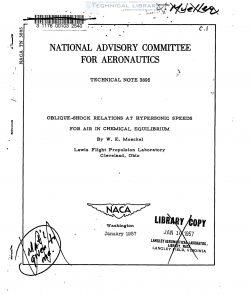naca-tn-3895
- Version
- 51 Downloads
- 1.10 MB File Size
- 1 File Count
- January 31, 2017 Create Date
- January 31, 2017 Last Updated
National Advisory Committee for Aeronautics, Technical Notes - Oblique Shock Relations at Hypersonic Speeds for Air in Chemical Equilibrium

Oblique-shock relations for air in chemical equilibrium have been
calculated for flight velocities up to 25,000 feet per second at altitudes
up to 200,000 feet. Results show that those shock parameters which are
functions only of Mach number normal to the shock for an ideal gas are
strongly influenced by flight altitude (initial conditions), as well as
normal Mach number, when dissociation takes place.
The variation of flow-deflection angle with shock angle differs sig-
nificantly from that of an ideal gas. At an altitude of 100,000 feet and
a flight speed of 25,000 feet per second, for example, the wedge detach—
ment angle is about 14° larger than that obtained for an ideal gas.
Tables and charts of oblique-shock relations for air are currently
available only for downstream temperatures less than 50000 R (ref. 1).
Recent computations by the National Bureau of Standards of the properties
of air in chemical equilibrium at temperatures up to 15,0000 K (ref. 2)
permit extension of these charts to the regions of interest for hypersonic
aerodynamics of nonslender bodies. Some representative computations,
based on the data of reference 2, have recently been completed at the NASA
Lewis Laboratory and are reported herein. Although these computations are
not as detailed as those of reference 1, they contain sufficient informa-
tion to calculate with reasonable accuracy the inviscid flow quantities
downstream of oblique shocks of arbitrary strength for flight speeds up
to 25,000 feet per second and altitudes up to 200,000 feet. The principal
limitation in the use of the oblique-shock relations presented herein is
the assumption that the air is in equilibrium downstream of the shock.
Two evaluations of shock relations for air in equilibrium have been
published recently (refs. 5 and 4). Both references are limited to
normal-shock relations. Reference 5 was published before thermodynamic
data based on the corrected dissociation energy of nitrogen (9.76 electron
volts) became available. Reference 4 uses the corrected thermodynamic
data and compares results with the values obtained with the previously ac—
cepted nitrogen dissociation energy of 7.57 electron volts.
| File | Action |
|---|---|
| naca-tn-3895 Oblique Shock Relations at Hypersonic Speeds for Air in Chemical Equilibrium.pdf | Download |
Comment On This Post